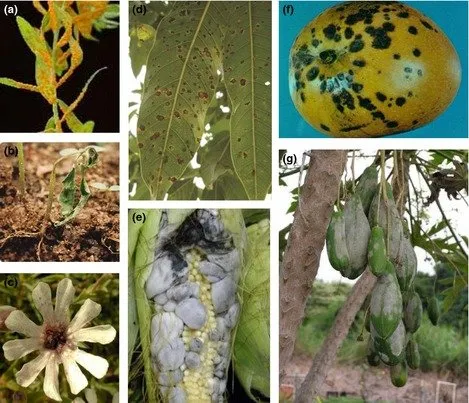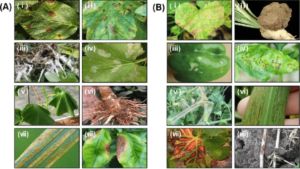Keep your garden healthy! Learn to identify and combat common fungal diseases in plants with our expert guide.
Introduction: How to Spot and Stop Fungal Diseases
Whether you’re a veteran gardener or just starting to nurture your green thumb, fungal diseases can be a real headache. These pesky infections can affect everything from your beloved roses to your tasty tomatoes. Don’t worry, though! In this blog post, we’ll dive into the world of fungal plant diseases, and arm you with the knowledge you need to keep your garden thriving.
Fungal plant diseases are a common issue faced by gardeners and farmers alike. These diseases are caused by fungi that feed off living plants and can lead to various symptoms such as spots, rot, wilting, and unusual coloration. Some common types of fungal plant diseases include leaf rust, stem rust, Sclerotinia, powdery mildew, birds-eye spot on berries, damping off of seedlings, and leaf spot.
To spot fungal plant diseases, it’s essential to know what to look for. Common signs include red and orange spots (rust), circular or irregularly shaped spots on leaves (leaf spot), dark, sunken lesions on stems and fruits (Anthracnose), orange, yellow, or brown powdery pustules on leaves (Rust), and fuzzy, grayish growth on the underside of leaves (Downy Mildew)1. Some specific diseases, such as Black Spot on roses, Botrytis Blight, and Fusarium Wilt, have their unique symptoms.
Preventing fungal plant diseases is crucial for maintaining a healthy garden. Some tips for prevention include planting resistant varieties, proper watering, good air circulation, careful mulching, and sanitation practices such as removing and destroying infected plant parts. Natural remedies such as Neem Oil, Baking Soda Spray, and Garlic Spray can also be used to control fungal diseases.
When it comes to controlling fungal plant diseases, cultural practices are often the first line of defense. This includes controlled watering practices, adequate spacing between plants, picking up or picking off infected material, and applying fungicides before infection begins. However, in most cases, fungal leaf spot diseases are not significant enough to warrant fungicide applications, and cultural practices are typically all that is necessary to manage leaf spot problems.
In summary, spotting and stopping fungal plant diseases requires knowledge of the signs and symptoms, implementing preventative measures, and using cultural practices to control the spread of the disease. By taking proactive steps, gardeners can maintain healthy plants and gardens.
What Exactly are Fungal Plant Diseases?
Let’s start with the basics. Fungal diseases are caused by microscopic organisms called fungi. These little critters thrive in warm, moist environments, making your garden a prime target. They spread through spores, which can easily travel through the air, water, and even on your gardening tools.
Spotting the Signs: Common Fungal Diseases
The key to stopping fungal diseases is early detection. Here are some of the most common culprits you might encounter:
- Powdery Mildew: A telltale white, powdery coating on leaves and stems. Think of a bad sprinkle of flour all over your plant.
- Rust: Rusty orange or brown spots on leaves, usually found on the underside.
- Black Spot: Black, circular spots that appear on leaves, often starting at the bottom of the plant and spreading upwards.
- Leaf Spot: Various sized spots of discoloration on leaves, often brown, yellow, or with a dark ring.
- Blights: Rapid browning, wilting, and death of leaves, stems, or entire plants.
Why Do Fungal Diseases Happen?
Several factors can make your plants more susceptible to fungal diseases:
- Overcrowding: Lack of air circulation creates the perfect moist environment for fungi.
- Excessive Moisture: Always remember to keep the foliage dry, especially overnight.
- Stress: Plants under stress from heat, drought, or poor soil are more vulnerable.
- Injured Plants Wounds and cuts can be entry points for infection.
Stopping Fungal Diseases in Their Tracks
Now for the good news—you can fight back! Here’s a multifaceted approach to keeping your plants healthy:
Prevention is Key
- Choose resistant varieties: Ask your local nursery for plants bred to resist common fungal diseases.
- Plant in the right spot: Plants need proper light and airflow – follow their care instructions carefully.
- Prune for good air circulation: Promote airflow and prevent overcrowded branches and leaves.
- Sanitation is your friend: Clean up fallen leaves, diseased plant parts, and sanitize tools often to stop the spread.
Smart Watering Techniques
- Water at the soil level: Do this to avoid wetting the leaves.
- Water early in the day: Any moisture on leaves has time to evaporate before nightfall.
Natural Remedies
- Neem oil spray: This natural antifungal is a great tool for prevention and mild cases.
- Baking soda solution: A simple homemade remedy for powdery mildew. (Mix 1 tablespoon of baking soda with 1 gallon of water and a touch of dish soap)
When to Call in Chemical Fungicides
- Severe infections: If the situation is out of control, targeted fungicides may be necessary.
- Identification is important: Be sure to identify the specific fungus before applying fungicides to maximize their effectiveness. Always follow label instructions carefully.
Common Signs of Fungal Plant Diseases
- Powdery Mildew: White powdery spots on leaves.
- Leaf Spot: Circular or irregularly shaped spots on leaves.
- Anthracnose: Dark, sunken lesions on stems and fruits.
- Rust: Orange, yellow, or brown powdery pustules on leaves.
- Downy Mildew: Fuzzy, grayish growth on the underside of leaves.
What are the common types of fungal plant diseases?

The common types of fungal plant diseases include:
- Leaf rust (common leaf rust in corn)
- Stem rust (wheat stem rust)
- Sclerotinia (white mold)
- Powdery mildew
- Birds-eye spot on berries (anthracnose)
- Damping off of seedlings (phytophthora)
- Leaf spot (septoria brown spot)
- Chlorosis (yellowing of leaves)
These fungal diseases can affect various plants and crops, leading to visible symptoms like spots, wilting, discoloration, and other changes that indicate the presence of fungal pathogens.
What are the best ways to prevent fungal plant diseases?
The best ways to prevent fungal plant diseases include implementing various practices and strategies to create an environment that is less conducive to fungal pathogens. Some effective methods based on the provided sources are:
- Use Disease-Free Seed and Propagating Stock: Starting with healthy seeds and plants can prevent the introduction of fungal diseases into your garden.
- Practice Crop Rotation: Rotating crops can help break the disease cycle by preventing the buildup of pathogens in the soil.
- Destroy Infected Plant Materials: Removing and destroying any plant material that may harbor pathogenic fungi can help prevent the spread of diseases.
- Develop and Use Resistant Plant Varieties: Choosing plant varieties that are resistant to specific fungal diseases can be an effective preventive measure.
- Utilize Chemical and Biological Fungicides: When necessary, using fungicides with different mechanisms of action can help control fungal diseases. Alternating between different fungicides can prevent the development of resistance.
- Monitor Spore Spread: Installing spore traps in fields can provide early warning of the spread of fungal diseases. These traps help detect the presence of fungal spores in the air, allowing for timely preventive measures.
- Utilize Protectant Fungicides: Protectant fungicides like mancozeb, chlorothalonil, and copper-based fungicides can be applied to healthy plants to prevent spores from germinating or penetrating the host tissue.
By combining these preventive measures, gardeners can significantly reduce the risk of fungal plant diseases and maintain the health of their plants effectively.
Conclusion:
By being vigilant and proactive in your gardening practices, you can effectively spot and stop fungal plant diseases before they cause irreparable harm to your plants. Remember, prevention is key, so arm yourself with knowledge and take the necessary steps to keep your garden healthy and thriving.
FAQs:
A: While some fungal diseases can be managed with fungicides, prevention is often more effective than trying to cure an already infected plant.
A: Not all fungal diseases are equally damaging. Some may only cause cosmetic damage, while others can lead to plant death if left unchecked.
A: Humidity, poor air circulation, and overwatering create favorable conditions for fungal pathogens to thrive and infect plants.

Nice blog here Also your site loads up very fast What host are you using Can I get your affiliate link to your host I wish my site loaded up as quickly as yours lol
Thank you for the kind words! I’m glad you enjoyed the content. Looking forward to delivering more in the future. Also, feel free to check out my other website, Mindful Insurance Claim, for more valuable information and guides on insurance and claims.